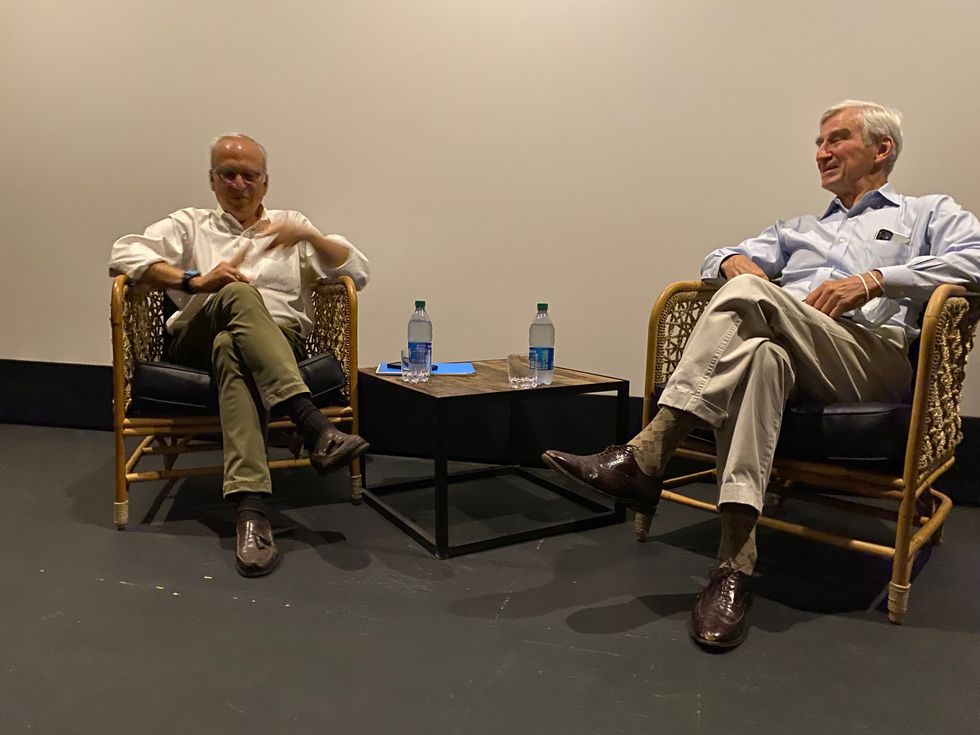MILLERTON — In celebration of 125 years of local weekly news publishing, The Lakeville Journal Foundation created a series of communitywide events, including a four-part film series at The Moviehouse in Millerton.
Each award-winning film portrayed the work of committed journalists.
On Saturday, Sept. 10, before the showing of “The Killing Fields,” a 1984 British biographical epic examining the role of two journalists covering Cambodia’s Khmer Rouge, Sam Waterston, who portrayed American journalist Sydney Schanberg, shared insights on the making of the film and the film’s lasting significance. Waterston was interviewed by former CBS News correspondent Richard Schlesinger of Cornwall.
Dan Dwyer, a member of the board of The Lakeville Journal Foundation, which publishes The Journal and The Millerton News, introduced the evening’s event.
Much of the film and the conversation beforehand touched on the experiences of heroic Cambodian photojournalist Dith Pran, whose story was told in graphic detail, showing the horrors endured by the Cambodian people.
The film chronicles the desperate story of one man, Pran, and his survival against all odds after the Khmer Rouge assumed power. His relationship with journalist Schanberg is tense with shared dependence in the face of fear and the need to survive.
“The film is not easy to watch,” Schlesinger noted, inquiring of Waterston, “What attracted you to the part?”
Waterston recalled that at the time, he was working on a TV series when he acquired a copy of the script. “I desperately wanted to play the part [of Schanberg],” he said.
“It’s not a classic Hollywood role,” Schlesinger said.
“[Schanberg] is a hero as a journalist,” Waterston said. “He had principles that got him into trouble. The important thing to be aware of is the quality of Sydney’s heart.”
Schlesinger recalled his own years as a news correspondent covering South American countries during times of political unrest, and the “nuanced situations,” that might result in heroic men or women being left behind, their lives in jeopardy, as Pran’s was.
“Lots of journalists over the years have tried to portray the story as one of betrayal,” Schlesinger said.
Once Pran had emigrated to the U.S. through the obsessive efforts of Schanberg, Pran had an opposite view, saying, “I love Sydney; Sydney did what he could.”
Pran, who was portrayed in the film by first-time actor Haing S. Ngor, who won an Academy Award for Best Supporting Actor. The film relived Pran’s experiences, plumbing the rawest depths of emotions, deprivations and torture he had endured throughout his imprisonment and escape on foot to Thailand.
“He understood his responsibility to live this as his own story,” Waterston said.
“If you know his story, these scenes are hard to watch,” Schlesinger added.
The award-winning film changed Waterston’s life. He went on to serve on the Board of Refugees International for several years, promoting the work of that organization in reaction to the issues raised in the film.
“Did the movie change the U.S. view of Cambodia?” Schlesinger asked.
“I hope so. It did make a difference. At least Cambodians thought their story was being told,” Waterston responded.










 Penguin Random House
Penguin Random House
 A needlework example.Cynthia Hochswender
A needlework example.Cynthia Hochswender Alexandra Peters, left, is exhibiting needlework samplers from her collection at the Litchfield Historical Society Museum.Cynthia Hochswender
Alexandra Peters, left, is exhibiting needlework samplers from her collection at the Litchfield Historical Society Museum.Cynthia Hochswender



